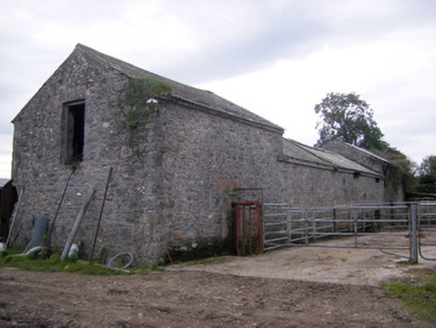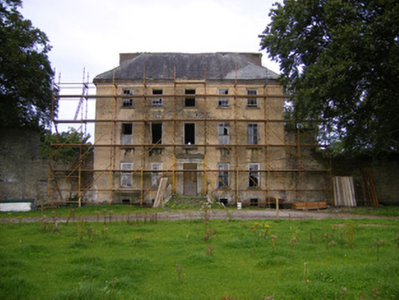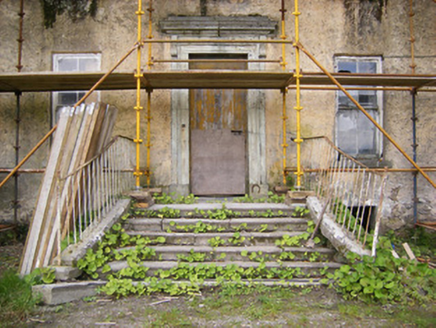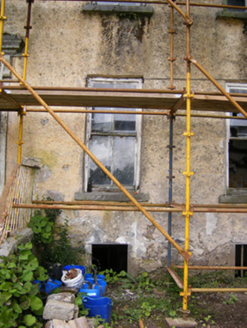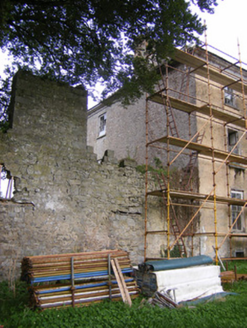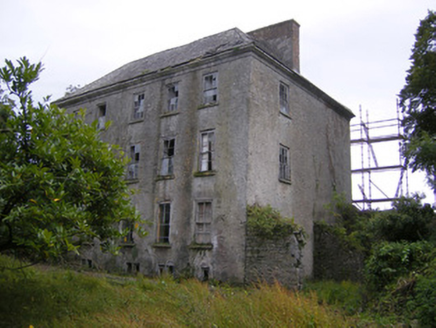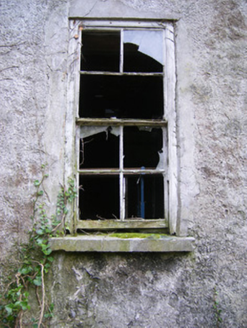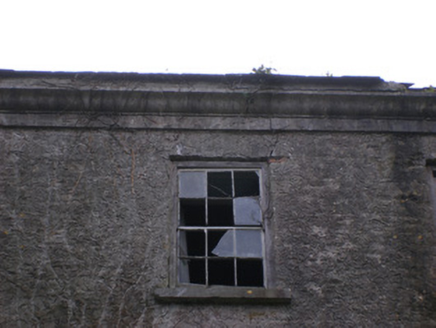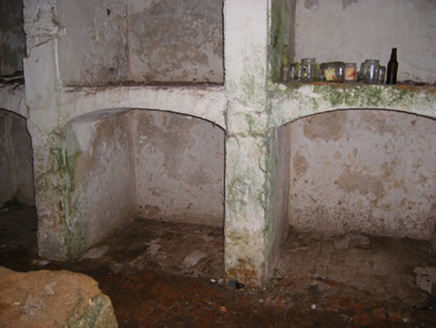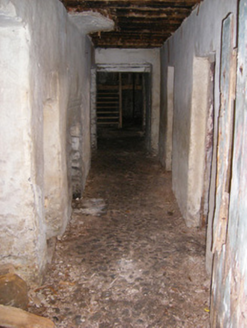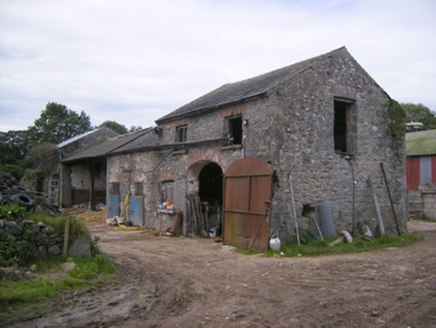Survey Data
Reg No
21901919
Rating
Regional
Categories of Special Interest
Architectural, Artistic, Historical, Social
Original Use
Country house
Date
1725 - 1735
Coordinates
133024, 143547
Date Recorded
16/09/2008
Date Updated
--/--/--
Description
Detached five-bay (two-bay deep) three-storey over part raised basement country house, built 1730, on a rectangular plan; five-bay full-height rear (north) elevation. Vacated, 1976. Now disused. Hipped slate roof on a quadrangular plan with clay ridge tiles, red brick Running bond chimney stacks on axis with ridge having capping supporting terracotta or yellow terracotta pots, and no rainwater goods surviving on cut-limestone ogee cornice retaining cast-iron hopper and downpipe. Part creeper- or ivy-covered lime rendered or roughcast walls with concealed cut-limestone flush quoins to corners. Square-headed central door opening approached by flight of six bull nose-detailed cut-limestone steps between wrought iron railings, cut-limestone doorcase with ogee-detailed hood moulding on fluted scroll consoles framing timber panelled door. Square-headed window openings (basement) with concealed cut- or hammered limestone surrounds framing cast-iron bars. Square-headed window openings with cut-limestone sills, and concealed dressings framing two-over-two or six-over-six (top floor) timber sash windows having part exposes sash boxes. Square-headed window openings to rear (north) elevation with drag edged dragged cut-limestone sills, and concealed dressings including cut-limestone voussoirs framing four-over-four or six-over-six (top floor) timber sash windows without horns having part exposed sash boxes. Square-headed window openings in bipartite arrangement (basement) with cut-limestone mullions, and concealed cut- or hammered limestone surrounds framing remains of timber casement windows. Interior including (ground floor): central hall retaining carved timber lugged surrounds to door openings framing timber panelled doors; and carved timber lugged surrounds to door openings to remainder framing timber panelled doors with carved timber surrounds to window openings framing timber panelled shutters on panelled risers. Set in unkempt grounds with tooled limestone ashlar piers to perimeter having remains of ogee-detailed cornice capping.
Appraisal
A country house erected for Justice Arthur Blennerhassett (1687-1758) to designs attributed to John Rothery (d. 1736) of Mount Ievers in County Clare (Bence-Jones 1978, 242) representing an important component of the early eighteenth-century domestic built heritage of County Limerick with the architectural value of the composition, one annotated as "Riddlestown [of] Blennerhassett Esqr." by Taylor and Skinner (1778, pl. 104), confirmed by such attributes as the deliberate alignment maximising on scenic vistas overlooking gently rolling grounds; the compact rectilinear plan form centred on a Classically-detailed doorcase demonstrating good quality workmanship in a silver-grey limestone; the diminishing in scale of the openings on each floor producing a graduated visual impression; and the high pitched roof. A prolonged period of neglect notwithstanding, the form and massing survive intact together with substantial quantities of the original fabric, both to the exterior and to the interior, including fragments of shimmering glass in hornless sash frames: meanwhile, contemporary joinery; and decorative plasterwork enrichments, all highlight the artistic potential of the composition. Furthermore, an adjoining walled garden (----); and adjacent outbuildings (----), all continue to contribute positively to the setting of a self-contained estate having historic connections with Arthur Blennerhassett (c.1700-1775) who drowned in a boating accident in Killarney and whose estate passed to his grandson Colonel Gerald Blennerhassett (aft. 1756-1806); Gerald Blennerhassett JP DL (c.1780-1845) and Elizabeth Blennerhassett (née Massey) (1782-1837); Gerald FitzGerald Blennerhassett JP DL (1809-76) and Geraldine Anne Blennerhassett (née FitzGerald) (1814-78) 'late of Riddlestown Park Rathkeale County Limerick' (Calendars of Wills and Administrations 1901, 26; 1904, 26); Gerald Urmston FitzGerald Blennerhassett (1845-86) 'late of Riddlestown Park County Limerick' (Calendars of Wills and Administrations 1886, 38); and George Ralph Fosbery (1854-1939) and Clara Elizabeth Urmston Fosbery (née Blennerhassett) (1843-1904) whose demise allowed Desmond FitzJohn Lloyd FitzGerald (1862-1936), twenty-seventh Knight of Glin, to sell the estate (1904) under the Irish Land Act of 1903 (Glin Papers).
